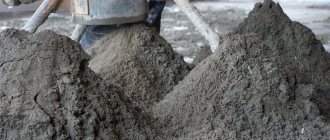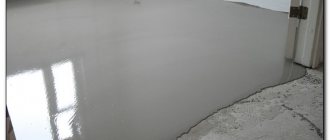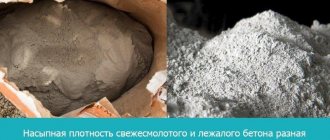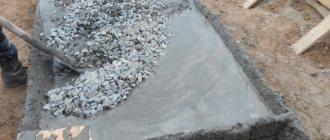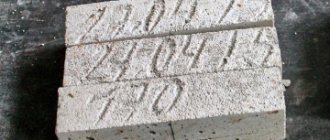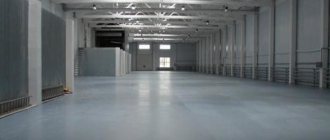Cement is a dry substance that is the basis for creating concrete mortar. It is the cement that becomes the binding base. Concrete is a mortar that is made from water, cement and aggregates. Special additives are also applicable that only increase the properties of concrete.
Cement mortar is used as a screed in front of the main flooring material, for example, in front of laminate, parquet, etc. Thick mortar is also a way to hide the seams between slabs and blocks. Plastering of various surfaces is done using cement mortar. The procedure allows you to strengthen and level the surface.
In order for cement to fulfill its properties, it is enough to add sand to the binder. Concrete requires mixing with coarse aggregate. Cement mortar can be improved using a plasticizing component. The additive will allow the solution to be used where mobility is needed, and will also add strength.
Cement mortar is commercially available in ready-made form, but it is also easy to prepare yourself. To do this, it is important to understand that it is best to end up with cement or concrete. In accordance with the need, the components are mixed according to technology.
Components
Professional builders divide the solution as follows:
• cement; • limestone; • cement-lime.
Experienced builders add various additives to the basic composition, which will add additional characteristics to the material. The following impurities improve the quality of the finished solution:
• slag; • silica; • ash; • limestone.
As a result, the solution will gain greater plasticity, harden faster, last longer, and also withstand various mechanical and chemical influences.
Use of special additives
Mineral supplements
When choosing or producing cement mortar, it is necessary to pay special attention to the possibility of using special additives. Currently, experienced builders prefer to use special mineral additives most often. As the latter, they choose fly ash, silica, lime or fine granulated slag. The use of such additives is due to a significant improvement in properties. Typically, it is the grades of cement under the codes CEM III, CEM IV and CEM V that are characterized by an incredibly high presence of mineral additives. CEM I grade cement is identified as pure, and CEM II grade is distinguished by a small amount of additives (no more than 20%).
Advantages
The additives described above permanently extend the service life of products, making them resistant to corrosion and other negative factors affecting the external environment. And under their influence the mixture itself becomes much more plastic, easier to work with, and it sets faster and more reliably. It should also be taken into account that the use of mineral additives in concrete mixtures is now becoming quite common.
Features of various compositions of concrete mixtures
Concrete has the following composition:
1. Binding component. As a rule, it is dry cement. 2. Sand – any type can be used. 3. Stone filler. 4. Water.
The use of various improving additives is permitted; the performance characteristics of the finished mixture will increase. Concrete requires special cement. Experienced builders most often turn to PC500. The finished mixture will be relevant for any purpose.
READ ALSO: What brand of concrete is needed for a strip foundation
It is important to prepare the concrete correctly. To do this, a correct calculation is made to find out how much cement is needed per 1 cubic meter. concrete. The presence of crushed stone and sand is taken into account; the granulometric composition must be in sufficient quantity, since it is the essence of strength and density. During factory production, the characteristics of each component are taken into account. Ease of use and long-term operation depend on correctly mixed fillers and binders.
Mixing concrete mortar yourself often occurs by eye, which leads to poor quality of the final result. An opportunity to improve the concrete mix is missed.
Designation of concepts
Cement
- a special solution, which is obtained by mixing sand, cement fractions and water, is used for the installation of various structures, laying out walls and other installation work. Builders introduce plasticizers into cement to increase strength. They give the solution such qualities as moisture resistance and frost resistance.
Concrete
is called a composite material in which cement, water and aggregates are mixed (most often different types of crushed stone and other components are used). In addition, there is concrete obtained by hardening a special mixture.
How additional components are used
Plasticizers have appeared on the building materials market. These are special fillers for building mixtures that help improve strength, ductility, and also extend service life.
You can also purchase fillers that will increase various characteristics, for example, to increase frost resistance, density, and also to reduce the hardening time of the solution. Anyone can easily buy them at any large hardware store. When adding, you must strictly follow the recommendations for use. Increasing the volume of additives may degrade the performance of the solution.
Distinctive properties of cement mortar according to purpose
If we talk about its purpose, cement mortar usually acts as a screed for floor coverings such as laminate, parquet, linoleum and much more. Very often, it is used to seal various seams between slabs and blocks. In addition, the composition is used for plastering of many surfaces. This allows you to give them an attractive appearance and compact the surface.
Unlike concrete mortar, the cement component does not require the introduction of coarse aggregate. Here you will get by just fine with regular sand. Very often you can see a plasticizer in the list of additives. It improves the mobility of the solution and increases its strength. And if you do not want to purchase a purchased version of the solution, you can make it yourself. Here you need to adhere to a certain regulatory document and study in advance the difference between concrete and cement.
What is reinforcing fiber
Concrete is a high-strength material, but its strength is not extreme. Durability can be maximized by adding reinforcing fiber to the mixture.
The following are used as reinforcing fibers:
1. Metal threads. 2. Fiberglass. 3. Polymer threads. 4. Basalt fiber.
The latter option is considered optimal, since basalt fiber does not rot, does not burn, and also has a much higher density. It is important to mix the solution well so that the reinforcing fiber is evenly distributed throughout the solution.
Definition of quality
Before use, it is very important to ensure that the quality of the concrete solution is sufficient. Usually quality is determined visually. If there are uncovered fractions of crushed stone in the solution, then it is necessary to add a little more sand to the mixture for greater viscosity. Another way to check the quality of concrete is by hitting it with a shovel. To do this, hit the concrete flat with force with an iron shovel: if the voids are almost not filled again with mortar, then there is not enough cement in the mixture. And if the mark remains too deep, then, on the contrary, the concrete has excess cement.
Types of concrete
There are several types of concrete. Classification is carried out on several grounds.
According to the area of application, concrete can be:
1. Special. The mixture is prepared in such a way that the concrete becomes stable. 2. Constructive. The composition is intended for creating various designs. 3. Straining. Concrete is used in conjunction with prestressing reinforcement.
Depending on the binder used in the composition, concrete is divided into:
1. Cement. Cement serves as the base. 2. Silicate. The mixture consists of lime raw materials and silicate material. 3. Plaster. A solution is made from slag with a base of gypsum binders.
READ ALSO: Technical characteristics of concrete B15, GOST and proportions
Which material is better
Leveling the floor surface with concrete is a classic option that has long been used in the construction industry. But even reinforcing concrete screeds with metal or composite mesh will never give the effect that sand concrete provides. The new universal material is very cheap. For example, the price for baumax M300 50 kg sand concrete is two times lower than for the same bag of concrete. At the same time, it combines several features:
- high strength;
- non-shrinkability;
- plastic;
- frost resistance;
- sound insulation;
- thermal insulation;
- waterproof.
The pouring technology of this building material is also superior to its competitors. When laying the foundation, the popular sand concrete Stone Flower M300 requires only leveling. The strength of the resulting surface will correspond to the marking - it will withstand a load of up to 300 kg/m3.
Thus, if you choose between concrete and sand-concrete screed, professionals are more likely to choose the second. It is more durable, more practical and economical.
conclusions
The difference between concrete and cement is great. It’s worth understanding exactly how the two materials differ:
1 area of use. Concrete has a wider range of applications in which the material is used. It is used in construction almost everywhere. Cement is mainly used in finishing works, masking cracks and depressions, and also as adhesion for laying building materials. 2. Composition. The lower strength of cement in relation to concrete is due to the minimal composition of the solution. Concrete has cement, crushed stone and sand in its composition, and also tolerates the inclusion of various additives - liquid compounds and reinforcing fibers. In addition, concrete is the basis for creating reinforced concrete, which is used for housing construction. 3. Decorative properties. Concrete finishing is used only for facades made of monolithic walls. But subsequently, good camouflage using cement mortar will be required. Leaving concrete unmasked is not acceptable. The finishing surface of concrete has many depressions, cracks, chips, as well as oil stains from the formwork. Unattractiveness dictates the need for finishing. 4. Service life. You need to know that concrete will increase in strength. The material will withstand negative impacts and strong physical stress, therefore it is most suitable for the construction of buildings, including as a foundation. A cement mortar of good quality will sooner or later begin to crack, gradually crumble, and eventually become unusable. Concrete, unlike cement, is a durable material. 5. Cost. Since concrete has more components, its cost is higher. 6. Consistency. The cement mortar is made dense, all components are mixed until uniform. Large aggregates in concrete make the composition less homogeneous. 7. Convenience. The homogeneity and relative thickness of the cement mortar make working with it easier. Concrete is more difficult to work with. When working with a concrete mixture, strict adherence to working rules is required, since if the size of gravel or crushed stone is incorrectly combined, the granulometric composition will be selected with an error, and if the solution is placed incorrectly, voids will form.
If you compare all the characteristics of concrete and cement, it will immediately become clear that the materials are completely different. The only thing they are similar in is their use in construction.
Preparation of sand concrete
An experienced builder is able to prepare this composition independently. For this you will need water, sand and Portland cement M 500. The proportions are simple - 3.5 kg of cement and no more than 2.5 liters of water are needed per bucket of sand.
The consumption of the prepared mixture is determined by the following conditions:
- required thickness;
- base parameters;
- high-quality condition of the finishing coating.
If a concrete mixer is used, the components must be dry so that they mix well.
Having laid the sand, add cement, stir and pour in water. The material will be homogeneous and will meet the strength requirements of M 300. The mixture is kneaded for several minutes, then sent to work.
Kawabanga! Density of different types of concrete in kg/m3
The brand of Portland cement used affects the strength of the sand concrete mass, and the sand fractions determine the degree of shrinkage. A universal option is composition M 300, although in practice it has been proven that low-grade solutions can also be used.
Transportation and storage of such material is carried out in four-layer paper containers that reliably protect from moisture.
Why is it profitable to buy building materials from AlfaCem?
You will not find such a large selection of high quality building materials in Moscow anywhere as in the group. Here you can buy M300 sand concrete of famous domestic and foreign brands. Among them are proven ones:
- Baumax;
- Dauer;
- Stone Flower;
- Installation Plus.
The catalog contains bags weighing 20, 25, 40 and 50 kg for long-term and short-term construction work. Minimum shipment – 40 bags of any volume.
Hundreds of construction companies and individuals are already cooperating with AlfaCem. They buy sand concrete mixture from the manufacturer on a regular basis. Benefits we offer:
- Quality and range. All suppliers of building materials are carefully selected and only those who offer the best products are included in the catalogue;
- Large volumes. Through the website you can order dry construction mixtures in any quantities from 1 pallet to several tons;
- Reasonable price. The price list is constantly updated, and discounts are provided for large wholesale purchases of sand concrete;
- Prompt delivery. Bags of cement mixtures are continuously delivered directly from a warehouse in Moscow throughout Russia;
- Professionalism. A qualified team is ready to help the client at every stage from selecting products to arranging delivery.
If you are interested in purchasing sand concrete M300 in small and large wholesale, you can get detailed advice by phone or online. The application form is available 24 hours a day.

